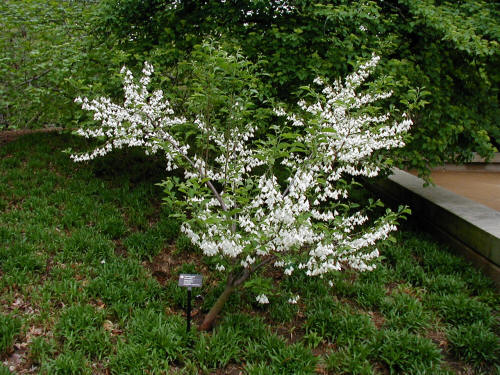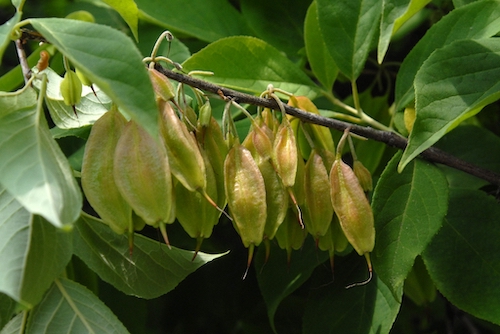The Beautiful Not So Common Silverbell
by Carolyn R. Casey, Fairfax Master Gardener
Are you looking for a beautiful and unique ornamental specimen tree to add to your garden? Do you want to attract pollinators, too? Then the common silverbell is just what you have been looking for. With its beautiful snow white bell-shaped blossoms, it is a stand out plant in the garden and is also a pollinator magnet.
 Common silverbell (Halesia tetraptera), formerly known as (Halesia carolina), is a Virginia native that grows in the western Virginia Piedmont area in Zones 7a and 7b. Halesia was named after Reverend Stephen Hale who was an 18th century English scientist and inventor. Tetraptera means four-winged referring to the four wings on each fruit. The name common silverbell comes from the shape of the flowers that look very much like small silver bells. It is also known as Carolina silverbell, mountain silverbell or opossum-wood. It is an attractive tree that can live for 100 years and grows at a moderate rate.
Common silverbell (Halesia tetraptera), formerly known as (Halesia carolina), is a Virginia native that grows in the western Virginia Piedmont area in Zones 7a and 7b. Halesia was named after Reverend Stephen Hale who was an 18th century English scientist and inventor. Tetraptera means four-winged referring to the four wings on each fruit. The name common silverbell comes from the shape of the flowers that look very much like small silver bells. It is also known as Carolina silverbell, mountain silverbell or opossum-wood. It is an attractive tree that can live for 100 years and grows at a moderate rate.
This tree prefers rich, moist, well drained loamy, acidic soil, with a pH of 5.0 to 6.0. At 7.0, the leaves become chlorotic, the yellowing of leaf tissue. This is due to lack of chlorophyll because nutrients are unavailable due to a high pH, alkaline soil. It also likes full sun to part shade. Common silverbell grows 20 to 40 feet tall and 18 to 30 feet wide. It grows along streams, river bluffs, ravine slopes, creek-banks and bottom lands. It is sensitive to heat, drought and soil compaction, and during drought conditions, it may need additional irrigation.

Silverbell as a small tree or shrub
Common silverbell may be grown as a large multi-trunked shrub or as an understory tree. Large trees have dramatic leaning and twisting trunks. When the common silverbell is young, it has gray bark with vertical dark fissures that make it appear as if it has stripes. As it matures, the bark is dark gray and may be mottled and scaly, ridged and furrowed. It separates into scales that peel off as the tree grows older. The stems are a brown copper and/or green color. Common silverbell has fine toothed dark green leaves that are oblong and are 2 to 5 inches long that appear at the same time or after it blooms. It is deciduous, and the leaves turn yellow in the fall.
With its soft wood and close grain, it is used to make wooden crafts. It has white or creamy sapwood and light cherry-colored heartwood with white streaks. Common silverbell is used for veneer, cabinet work, carving and turnings. It is sold to tourists as bellwood, tisswood and boxelder. Because of its soft and weak wood, the common silverbell needs to be protected from high winds and pruned in a manner to reduce its sail area allowing the wind to pass through the tree.

Silverbell fruit with seeds
Common silverbell blooms when it is just a few years old with beautiful small white bell-shaped flowers. Cultivars may have pink flowers that appear in March and May and are pollinated by insects. The flowers bloom for about a week. They appear in a cluster of 4 to 5 blossoms, and the flowers have 4 fused petals that are ¾ to 1 inch long. Common silverbell has variegated or splotched leaves. The flowers have a four-celled ovary, but only one cell produces a viable seed. The fruit of the common silverbell is a dry, oblong, four-winged drupe that matures in the fall.
It attracts hummingbirds and supports seven species of lepidopteran caterpillars, including the Promethea moth. It is the host plant for the Eastern Tiger Swallowtail, Mourning Cloak, Eastern Comma, Red-spotted Purple and Viceroy Butterflies. The buds and flower clusters are eaten by birds. Butterflies, bees and other pollinators enjoy the nectar from the flowers. The seeds that it produces are also eaten by squirrels, and the flowers provide honey for bees. It does not have any serious insect pests or diseases. It may develop Phytophthora root rot if not planted in well-drained soil.
It can be easily propagated by root and greenwood cuttings and air-layers. You do not need to use rooting hormones to propagate the cuttings but they may enhance rooting at certain times of year. It is best to take the cuttings after elongation of new growth and before hardening begins. The roots of new plants should not be disturbed until the second season. Common silverbell seedlings grow about 5 inches in their first seven weeks. Their growth will continue at a moderate rate for a few years and it then slows considerably. It has an irregular, spreading, open crown that is rounded, pyramidal or vase shaped.
Cultivars and varieties of common silverbell
‘Arnold Pink’ features ¾” long, rose-pink flowers that fade to very light pink. It was introduced by the Arnold Arboretum.
‘Crushed Velvet’ has bluish green smaller leaves with a wavy texture and fine textured branching.
‘Meehanii’ is a shrub-like form that grows to only 12 feet tall. It has numerous white flowers that are smaller than the species form, and the leaves are coarser and more wrinkled.
‘Rosea’ has flowers ranging from light rose to very light pink.
‘Silver Splash’ has green leaves with white or yellow splotches.
‘Variegata’ has white or yellow variegated leaves.
‘Wedding Bells’ is a smaller form with a rounded habit reaching 20 feet tall. This plant has more numerous white flowers that are larger than the species and open more fully and has shiny leaves.
The common silverbell is anything but common with its beautiful snow white bell-shaped blossoms and unique leaning and twisted trunk and is a delight to see all year long. Enjoy this beautiful and unique addition to your garden. Happy Gardening!
Resources
Halesia carolina, North Carolina Extension Gardener Toolbox
Silverbells, Joey Williamson, Clemson Cooperative Extension
How to Grow and Care for Carolina Silverbell, Vanessa Richins Myers, the Spruce
Carolina Silverbell, Earl R. Sluder, Virginia Tech
Common silverbell, Bernheim Arboretum and Research Forest
Chlorosis, James Schuster, Bruce Paulsrud, University of Illinois Extension